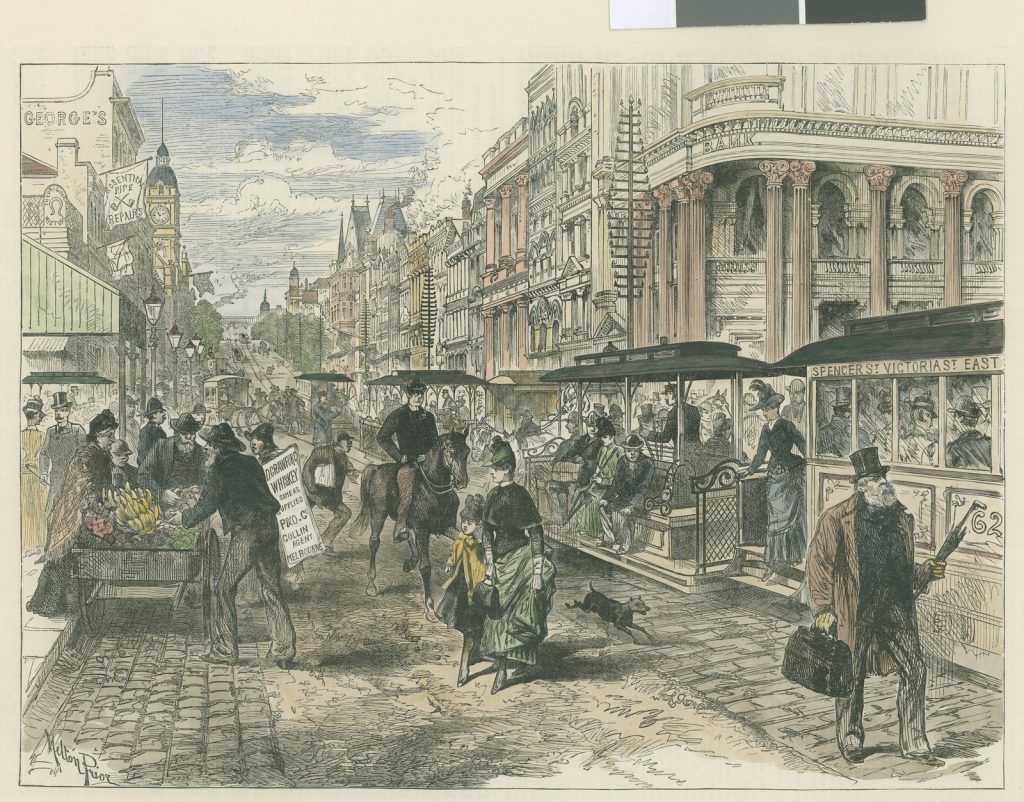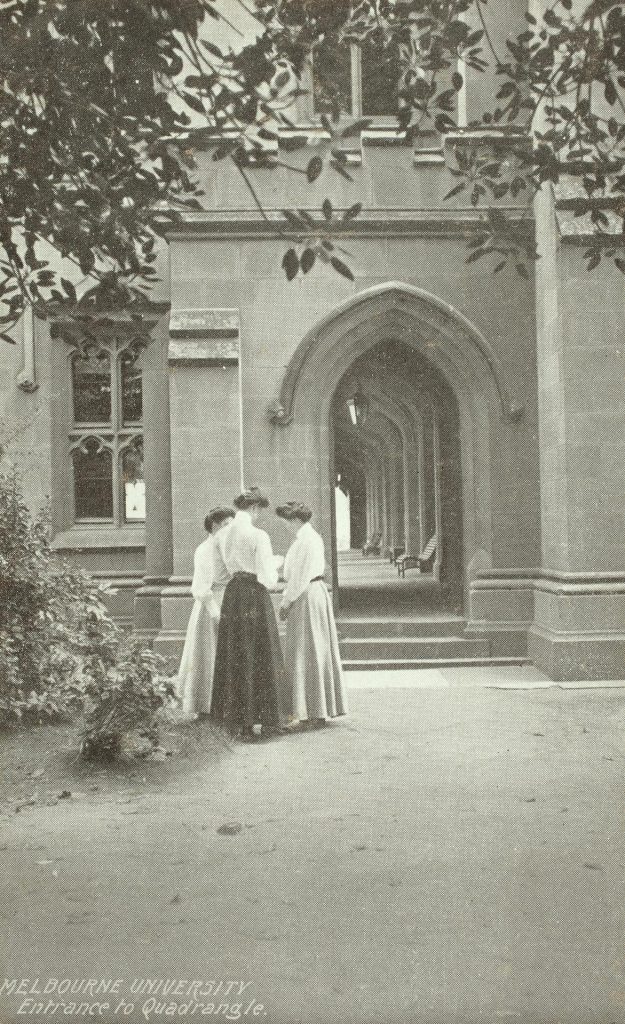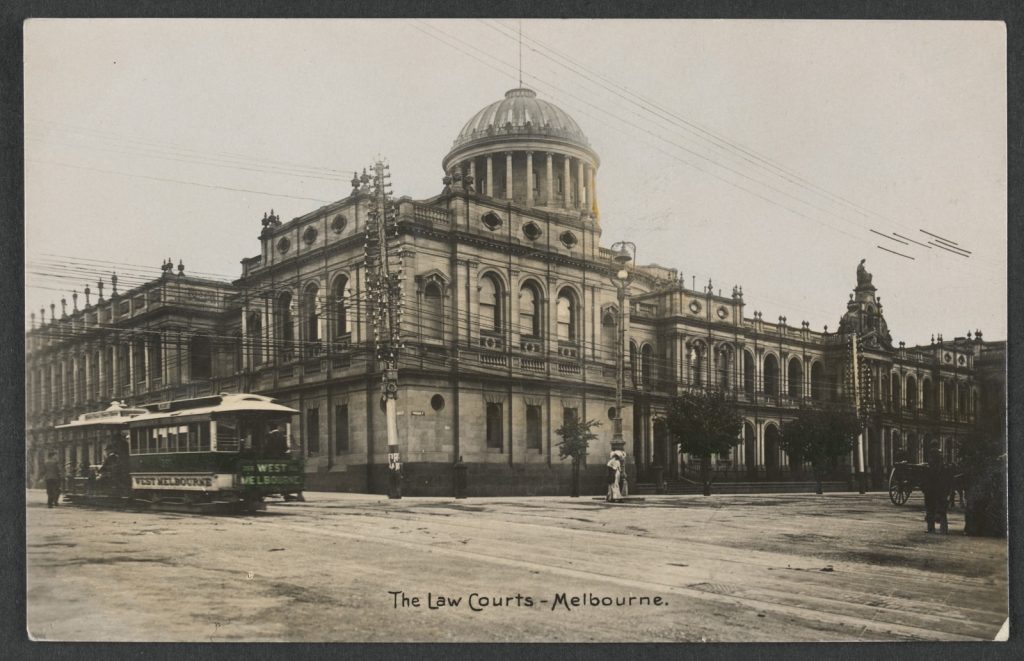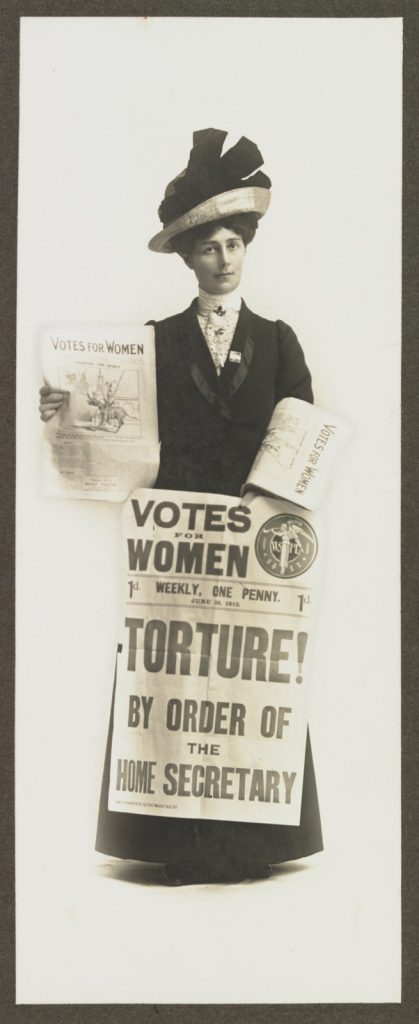On 1 August 1905, an unusually large crowd, including ‘ladies in bright dresses’, 1 descended on Melbourne’s Supreme Court building. The occasion was a momentous one. Ms Grata Flos Matilda Greig was about to become the first woman to be admitted to legal practice in Australia.

The road to admission had not been an easy one. Women were not allowed to vote or hold parliamentary office in Victoria, and there was widespread resistance to women practising law.2 But Flos was not easily dissuaded; nor was her upbringing a conventional one… for a woman.
Grata Flos Matilda Greig was born on 7 November 1880 at Broughty Ferry in Scotland — the fourth of eight children. When Flos was eight, her family moved to Melbourne, and her father, Gregory, joined his brother in their textile company. 3 Melbourne was in the middle of a land boom, so business opportunities were plentiful for the brothers.

Flos completed her secondary college at PLC, before deciding at age 16 to study law at university. There were already two other professional women in the family. Flos’s sisters, Jane and Janet Greig, were both qualified doctors. A third sister, Clara, ran a coaching college for university students.4
The girls’ father, Gregory, has been ascribed with some of the credit. As a young man, he’d been denied the opportunity of a tertiary education. He was determined that his daughters’ lives would be different. 5
In March 1903, Flos graduated from her law course to become Victoria’s first ‘Lady Bachelor-of-Laws’. The newspapers reported that she was a ’round-faced, rosy-cheeked, merry little lady’ whose appearance belied her qualification. When quizzed on her opinion about women and the law, Flos was forthright: ‘Women are men’s equals in every way, and they are quite competent to hold their own in all spheres of life.’ (Table Talk, 16 April 1903, p 10)6

Flos’s graduation was a watershed moment for Victoria, making it the first state in Australia to allow women to practise law. The Women’s Disabilities Removal Bill was passed on 3 April 1903 and the Legal Profession Practice Act 1903 (nicknamed the ‘Flos Greig Enabling Act’) was born.7 The Act stated:
No person shall by reason of sex be deemed to be under any disability for admission to practise as a barrister and solicitor of the Supreme Court, any Law or usage to the contrary notwithstanding.8
Flos went on to do her articles of clerkship with commercial law firm Snyden and Cornwall. When she finished, she gave an interview to social magazine, Table Talk. The journalist reported that Flos was ‘utterly unlike the accepted type of the strong-minded woman’, finding her to be ‘petite, slight and fair, essentially feminine and fond of pretty clothes, of social life and of such an absolute frivolity as dancing.’ (Table Talk, 18 May 1905, p 6)9
Despite these perceived incongruities, Flos was admitted to practice on 1 August 1905. The Herald reported:
The young lady is slight of figure, with light hair and a fair complexion. She was tastefully attired in a fawn-coloured costume and toque to match, adorned with violets and ferns. The lady wore a pair of white gloves. (The Herald, 1 August 1905, p 6)10
There was much speculation as to whether Flos would ‘wear a wig’. She was quick to answer:
‘No, I do not intend to appear in Court, except to instruct a case. It is not my intention to practise as a barrister, but to confine myself to the practise of a solicitor.’ (Table Talk, 18 May 1905, p 6)

The Sydney Mail predicted that Flos would do well in her profession, ‘provided she can curb her sex’s “native impulsiveness” which constantly urges them into extremes, and prevents them from “looking all round” at matters submitted to their judgement.’ (Sydney Mail, 16 August 1905, p 400)
A week or so later, Flos joined women’s suffragist Vida Goldstein at a public meeting to lobby Victoria’s Upper House to pass women’s suffrage into law. 11 The Argus reported:
Miss Flos Greig, L.L.B., said… The chief point for discussion was not whether women were fit for politics, but whether politics were fit for women. If the politics were not fit, the sooner they were made so the better. (Applause.) As regarded the assertion that the giving of the voting power to women would cause dissension in, and even the breaking up of, homes, it was as well to bear in mind that neither the Police Court nor the Divorce Court had had any extra work in consequence of the last federal elections, at which women voted. (Laughter) (The Argus, 12 August 1905, p 16)12

Flos established an office in the Royal Bank Chambers at 70 Elizabeth Street where she remained for several years. One of her earlier jobs was for the Women’s Christian Temperance Union, drafting proposed amendments to the bill that led to the passing of legislation for the creation of the Children’s Court in Victoria. 13 She became known as a public speaker, often speaking on issues close to her heart, such as the abolition of capital punishment, and legal inequalities facing women and children.14
In July 1908 Flos was admitted to hospital with an undisclosed ‘serious illness’ that had started with a chill. 15 In February 1912 the Ballarat Star reported she had recovered, but by May it was revealed that Flos was still unwell, so much so that she was in ‘enforced retirement’. 16
By 1914, Flos had finally recovered. 17 There were now seven women practising law in Victoria. They formed a Women’s Law Society of Victoria and elected Flos as their first president. 1819

Flos was very fond of travel, and from 1914 onwards, she embarked on many overseas adventures. She loved to learn about new people and places, particularly those of South East Asia. Her nephew, Barton Hack, recalled that Flos was ‘much more interested in Eastern religions and customs than in European Australia.’20 Flos gave many public lectures about her travels, which included slide shows to entertain the public. She regularly appeared on ABC radio 3LO, discussing topics such as: ‘the geography of China’, ‘the religion of Buddha in Southern Asia’, and ‘the development of the Malay states’.21
In the 1920s, Flos worked as a solicitor in Geelong22 before moving to Wangaratta in 1928, where she worked as a solicitor for Paul McSwiney.23 She purchased a motor car — a Baby Austin tourer — and explored the mountainous roads of north-eastern Victoria.24 Flos also remained busy supporting various causes. She backed efforts to improve adult education facilities in the area, and became involved with the Douglas (Social) Credit movement.25
Flos retired to Rosebud, on the Mornington Peninsula, in 1942, before moving into a St Kilda Road boarding house in her seventies. She died of pneumonia in 1958. 26
Postcript
In 2001, Flos Greig was inducted into the Victorian Honour Roll of Women. There is a street named after her in Walton, Canberra.
Further reading
Campbell, R & Hack, J B, ‘Greig, Grata Flos Matilda (1880–1958)’, Australian Dictionary of Biography, National Centre of Biography, Australian National University
Halonkin, L, 2014, ‘Greig, Flos (1880 – 1958)’, The Encyclopedia of Women and Leadership in Twentieth-Century Australia [online resource], Australian National University
Mathews, I, 2022, Flos Greig: Australia’s first woman lawyer, Cornwalls, Melbourne, Vic
References
- ‘First Lady Barrister’, The Herald, 1 August 1905, p 6
- Mathews, I, 2022, Flos Greig: Australia’s first woman lawyer, Cornwalls, Melbourne, Vic, p 11
- Campbell, Ruth and Hack, J Barton, ‘Greig, Grata Flos Matilda (1880–1958)’, Australian Dictionary of Biography. Accessed on 1 July 2023
- Mathews, I, 2022, Flos Greig: Australia’s first woman lawyer, Cornwalls, Melbourne, Vic, p 1
- Mathews, I, 2022, Flos Greig: Australia’s first woman lawyer, Cornwalls, Melbourne, Vic, p 4
- As above, p 22
- As above, p 21
- As above
- As above, p 26
- As above
- As above, p 31
- As above, p 31-2
- Campbell, R & Hack, J Barton, ‘Greig, Grata Flos Matilda (1880–1958)’, Australian Dictionary of Biography, National Centre of Biography, Australian National University. Accessed 12 May 2023
- Halonkin, L, 2014, ‘Greig, Flos (1880 – 1958)’, The Encyclopedia of Women and Leadership in Twentieth-Century Australia [online resource], Australian National University
- ‘Our Ladies Letter’, Ovens and Murray Advertiser, 25 July 1908, p 4
- ‘My Learned Sister’, Australian Town and Country Journal, 29 May 1912, p 35; Mathews, I, 2022, Flos Greig: Australia’s first woman lawyer, Cornwalls, Melbourne, Vic, p 37
- ‘Social Circle’, Leader, 31 January 1914, p 50
- ‘Women’s Law Society’, Weekly Times, 5 September 1914, p 10
- Mathews, I, 2022, Flos Greig: Australia’s first woman lawyer, Cornwalls, Melbourne, Vic, pp 39-40
- Mathews, I, 2022, Flos Greig: Australia’s first woman lawyer, Cornwalls, Melbourne, Vic, p 45
- As above, pp 44-49
- As above, p 42
- As above, p 50
- As above, p 51
- Campbell, R & Hack, J B, ‘Greig, Grata Flos Matilda (1880–1958)’, Australian Dictionary of Biography, National Centre of Biography, Australian National University. Accessed 12 May 2023
- Mathews, I, 2022, Flos Greig: Australia’s first woman lawyer, Cornwalls, Melbourne, Vic, p 45



Were women legislatively barred from practising as lawyers, before the two Acts on 1903? If so Flos was a very brave woman studying Law in the late 1890s.
Hi Helen, thanks for your interest. Yes, when Flos started studying law in 1897, it was illegal for women to practise as lawyers. It was a very brave decision indeed.
There was just the one act in 1903: the Women’s Disabilities Removal Act, but it is often referred to as the “Flos Greig Enabling Act” which is why you may have been under the impression there were two. Sarah
Wow, Miss Greig sounds amazing! Thanks for sharing her story.
It sounds like she would be a great candidate for a statue in her honour, and for her name to perhaps grace one of the new building the University is planning.
Thankyou for this blog. Is there a collection of such stories about lesser-known historical figures?
Hi June, Thanks for your interest. The Australian Women’s Register is a great online resource where you can find the diverse stories of many lesser known Australian women, both past and present. The Australian Dictionary of Biography is also excellent. You can find fascinating descriptions of the lives of over 13,000 significant and representative persons in Australian history. The subjects come from all walks of life — providing a cross-section of Australian society. Sarah
We should have a street named after her in Melbourne!
Flos truly does sound amazing! Such an intelligent, modern thinker. A true trailblazer. It’s women like her that have bettered our lives today. Thanks for making my day and telling her story, and thank you Flos for making a difference. It’s made me well up with pride, just like the Matilda’s did for so many of us recently.